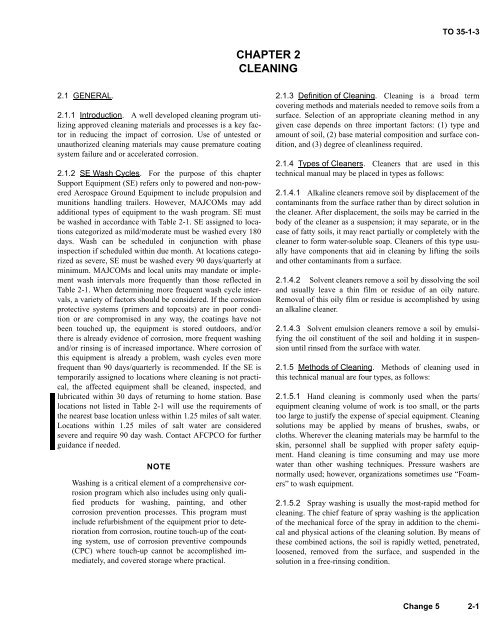TO 35-1-3 - Robins Air Force Base
TO 35-1-3 - Robins Air Force Base
TO 35-1-3 - Robins Air Force Base
Create successful ePaper yourself
Turn your PDF publications into a flip-book with our unique Google optimized e-Paper software.
<strong>TO</strong> <strong>35</strong>-1-3<br />
CHAPTER 2<br />
CLEANING<br />
2.1 GENERAL.<br />
2.1.1 Introduction. A well developed cleaning program utilizing<br />
approved cleaning materials and processes is a key factor<br />
in reducing the impact of corrosion. Use of untested or<br />
unauthorized cleaning materials may cause premature coating<br />
system failure and or accelerated corrosion.<br />
2.1.2 SE Wash Cycles. For the purpose of this chapter<br />
Support Equipment (SE) refers only to powered and non-powered<br />
Aerospace Ground Equipment to include propulsion and<br />
munitions handling trailers. However, MAJCOMs may add<br />
additional types of equipment to the wash program. SE must<br />
be washed in accordance with Table 2-1. SE assigned to locations<br />
categorized as mild/moderate must be washed every 180<br />
days. Wash can be scheduled in conjunction with phase<br />
inspection if scheduled within due month. At locations categorized<br />
as severe, SE must be washed every 90 days/quarterly at<br />
minimum. MAJCOMs and local units may mandate or implement<br />
wash intervals more frequently than those reflected in<br />
Table 2-1. When determining more frequent wash cycle intervals,<br />
a variety of factors should be considered. If the corrosion<br />
protective systems (primers and topcoats) are in poor condition<br />
or are compromised in any way, the coatings have not<br />
been touched up, the equipment is stored outdoors, and/or<br />
there is already evidence of corrosion, more frequent washing<br />
and/or rinsing is of increased importance. Where corrosion of<br />
this equipment is already a problem, wash cycles even more<br />
frequent than 90 days/quarterly is recommended. If the SE is<br />
temporarily assigned to locations where cleaning is not practical,<br />
the affected equipment shall be cleaned, inspected, and<br />
lubricated within 30 days of returning to home station. <strong>Base</strong><br />
locations not listed in Table 2-1 will use the requirements of<br />
the nearest base location unless within 1.25 miles of salt water.<br />
Locations within 1.25 miles of salt water are considered<br />
severe and require 90 day wash. Contact AFCPCO for further<br />
guidance if needed.<br />
NOTE<br />
Washing is a critical element of a comprehensive corrosion<br />
program which also includes using only qualified<br />
products for washing, painting, and other<br />
corrosion prevention processes. This program must<br />
include refurbishment of the equipment prior to deterioration<br />
from corrosion, routine touch-up of the coating<br />
system, use of corrosion preventive compounds<br />
(CPC) where touch-up cannot be accomplished immediately,<br />
and covered storage where practical.<br />
2.1.3 Definition of Cleaning. Cleaning is a broad term<br />
covering methods and materials needed to remove soils from a<br />
surface. Selection of an appropriate cleaning method in any<br />
given case depends on three important factors: (1) type and<br />
amount of soil, (2) base material composition and surface condition,<br />
and (3) degree of cleanliness required.<br />
2.1.4 Types of Cleaners. Cleaners that are used in this<br />
technical manual may be placed in types as follows:<br />
2.1.4.1 Alkaline cleaners remove soil by displacement of the<br />
contaminants from the surface rather than by direct solution in<br />
the cleaner. After displacement, the soils may be carried in the<br />
body of the cleaner as a suspension; it may separate, or in the<br />
case of fatty soils, it may react partially or completely with the<br />
cleaner to form water-soluble soap. Cleaners of this type usually<br />
have components that aid in cleaning by lifting the soils<br />
and other contaminants from a surface.<br />
2.1.4.2 Solvent cleaners remove a soil by dissolving the soil<br />
and usually leave a thin film or residue of an oily nature.<br />
Removal of this oily film or residue is accomplished by using<br />
an alkaline cleaner.<br />
2.1.4.3 Solvent emulsion cleaners remove a soil by emulsifying<br />
the oil constituent of the soil and holding it in suspension<br />
until rinsed from the surface with water.<br />
2.1.5 Methods of Cleaning. Methods of cleaning used in<br />
this technical manual are four types, as follows:<br />
2.1.5.1 Hand cleaning is commonly used when the parts/<br />
equipment cleaning volume of work is too small, or the parts<br />
too large to justify the expense of special equipment. Cleaning<br />
solutions may be applied by means of brushes, swabs, or<br />
cloths. Wherever the cleaning materials may be harmful to the<br />
skin, personnel shall be supplied with proper safety equipment.<br />
Hand cleaning is time consuming and may use more<br />
water than other washing techniques. Pressure washers are<br />
normally used; however, organizations sometimes use “Foamers”<br />
to wash equipment.<br />
2.1.5.2 Spray washing is usually the most-rapid method for<br />
cleaning. The chief feature of spray washing is the application<br />
of the mechanical force of the spray in addition to the chemical<br />
and physical actions of the cleaning solution. By means of<br />
these combined actions, the soil is rapidly wetted, penetrated,<br />
loosened, removed from the surface, and suspended in the<br />
solution in a free-rinsing condition.<br />
Change 5 2-1
















